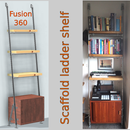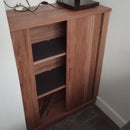Introduction: Adirondack Deck Chair
I just bought myself a new bell tent this summer which is very swish. I have a camping chair but it is one of those generic fold out chairs with a cup holder, fairly comfortable and practicable yes, in-keeping with my new tent no! I needed a new one.
I have made a couple of Adirondack chairs before so I knew they were super comfy but not particularly easy to take up and down and pack away in to a camping friendly package. After a few days thinking of ideas I came up with replacing the seat and back slats with a waterproof canvas much like a traditional deck chair. I had a large piece of pippy oak at home so jotted down some rough dimensions and it looked like I needed that bit and another I had lying around...happy days!
I had made a chair like this one Rubber hose chair by Wholman but with rope and I still had some plywood cut to the right dimensions, so before going straight in to this project I made a plywood and canvas chair to prove the method of fixing and test my sewing skills.
Materials
Timber - the following dimensions are the final ones I took from the finished chair. They were all about 22mm thick.
2No 680mm x 90mm for the rear uprights
2No 395mm x 90mm for the front uprights
2No 940mm x 90mm for the main supports
2No 780mm x 110mm avg for the arms (average because I used the waney edge of the board)
4No 115mm x 38mm - 55mm for the arm supports
1No 477mm x 22mm for the lower cross brace
1No 434mm x 22mm for the upper cross brace
28No 30mm long 6mm diameter cross dowel bolts
4No 6mm metal cross dowels
8No 6mm diameter joint connector nuts
Waterproof canvas 1200mm x 450mm for the seat
Waterproof canvas 400m x 150mm for the nut bag
Waterproof canvas 1000mm x 800mm for the chair bag
Paracord for the bag ties
A suitable uv anti-fungal finish - i used Osmo 420
Tools
Table saw
Planer thicknesser
Sander
Drill with various bits
Tap and die set (only need the tap)
Sewing machine
Step 1: Cut, Plane and Thickness Your Wood
The first thing you will need to do is cut your timber down to a sensible size for planing. I have only got a small workshop (2m x 2m) so I cut my timber quite short. Most of the pieces were their final size before I put them through the planer, I did leave the two short uprights as one and I could just manage to get all the bits in and out the planer thicknesser (constantly knocking things over and poking the ends out of doorways!).
The photo of the main support has dimensions written on in pencil you should be able to make out, the diameters of both the quarter circles are 110mm and the triangular cut out is 140mm x 40mm.
Once all the parts are cut and planed, I routed a curve to all the external edges and sanded them with 80, 120, 180 and 240 grit sand paper using a random orbital sander.
Step 2: Determine the Location of the Fixings
As I wanted the chair to be portable I needed fixing that would be easy to use and wouldn't wear out. I had seen connectors on flat packed furniture before which seemed to be ideal. For fixing face to face connections I used joint connector nuts and dowel bolts and for the face to end connections on the cross beams I used dowel bolts and cross dowels. These also have the advantage of taking hex keys which will take up little space in the final bag.
I rigged up one side of the chair using clamps and adjusted the location of the uprights until they looked about right and then drilled two pilot holes in each support timbers. For each part that was connected I used two different diameter holes - the side that will take the bolt was the bolt diameter size and the opposite face was drilled to thee joint connector nut size. As it turned out the joint connector nuts were nice and tight in the holes and needed some hammering to get them in to place which turns out really good as there will be less to lose on a camping trip.
I decided to do the arms later once I had sorted out the canvas.
Once I had made all my holes I put my frame together.
Step 3: Make the Canvas Seat
This next step involved sewing but I had only made a chair canvas once before a week previous and I had no other experience prior to that.
My mum had an old sewing machine that was lying around at my brothers and wasn't using so I used that one, fortunately the instruction manual was with the machine (my mum couldn't teach me though as she lives in France and I live in the UK, so self teaching it was). I did have a little practice threading the machine and sewing a few lines in some material before I attempted to sew my first seat.
As I have no knowledge about the best way to sew something like this it may not be best to follow these steps as there may be a better, easier way to to it. Even if it is doing the same things but in a different order.
I started off by folding the two sides in by around 10mm, held it with pins and began to sew. The idea was slow and steady which turned out to be varied and slow turned in to slow and fast. But it does look like it will hold for while at least.
Next I folded over the top of the canvas to hold the top cross timber. Once that was done I attached that part to the chair with the canvas and held the bottom of the canvas on with clamps which I adjusted to get the right length. Once I'd established my perfect length I sewed the bottom of the canvas and put the chair together.
Step 4: Attach the Arms
I left the arms until last just so I could work out the shape I needed to cut them. I held the arms at the right height and worked out where abouts I needed to cut. To attach the arms to the uprights I decided to use a tapered piece of wood but thought that any mechanical fixings wouldn't be easy to use, so I decided to tap a thread in to the wood so I could screw a bolt through the arms. Having tried out a test piece these seemed to work quite good if you screwed in the bolt far enough, hopefully they will last repeated use. Having put the front of the arm on to the upright I levelled the arm with a level and attached the back of the arm.
Step 5: Finishing Touches
To finish and protect the wood I used an oil with UV protection and anti-fungal properties. The make I used was Omso 420 clear oil, its expensive but all the reviews I read on line pointed to this one as being one of the best to use. I just applied two coats of the oil with a rag leaving the coats 24 hours in between.
As this is meant to be a portable chair it needs to be contained in something easily transportable. The first thing I did was to make a small bag for the bolts and seat fabric which just about fit in the bag, the string for the bag is paracord in true instructable style.
Lastly I made a bag for all of the chair. I made this like the smaller bag but attached a strap to the outside before I sewed it together so I could put it round my shoulder to carry.
All in all this chair worked out really well and I am pleased with the result. I just need the weather to improve otherwise I'll have to wait until next summer to use it when camping!

Finalist in the
squeeze more awesome out of summer contest

Participated in the
Teach It! Contest Sponsored by Dremel

Participated in the
Remix Contest













